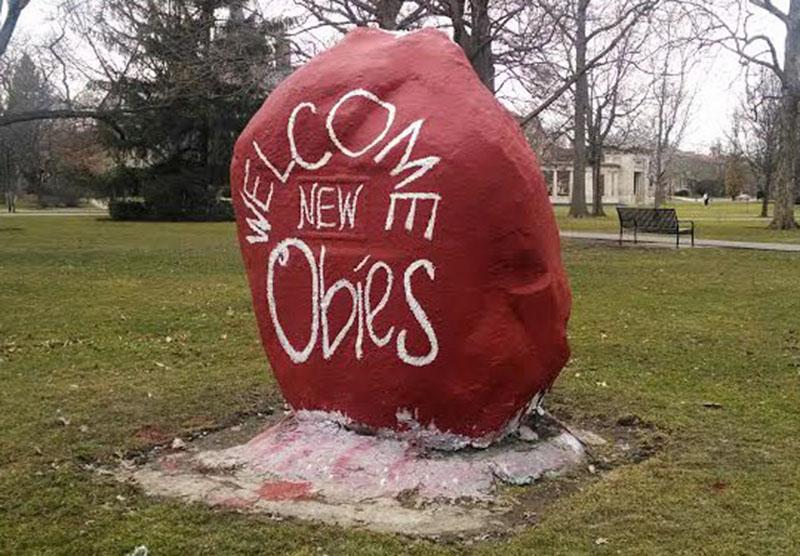Acceptance Letters Mailed to Over 2,000 Prospective Students
Oberlin admission staff prepares for the arrival of the class of 2018. These preparations include sending admission letters, listening to audition tapes and painting rocks.
April 6, 2014
College and Conservatory admissions officers mailed much anticipated acceptance letters on April 1 to welcome the incoming freshman class.
Debra Chermonte, the vice president and dean of admissions and financial aid said the College invited a third of this year’s 6,100 applicants. Of the admitted students for the Class of 2018, Chermonte said, “About 26 percent of the students who were offered admission identified themselves as students of color, and we have a very, very strong international class this year, from all around the world.”
Before acceptance, a prospective student’s application must be endorsed by two admissions counselors and then approved by a larger admissions subcommittee.
“We do a holistic review of each application,” said Tom Abeyta, senior associate director of admissions and director of recruitment. Abeyta noted that this year’s prospective students shared more “emotional stories” in their applications than in the past, causing some committee members to cry during the review process.
Chermonte said the College does not “over perseverate testing,” but rather emphasizes a “rigor of a curriculum” and the
extent to which students took advantage of opportunities and classes offered at their given high schools. Oberlin’s admissions process values individual qualifications and does not set quotas on the number of students admitted from a given school, according to Chermonte.
“We want to make sure we are fair and consistent within our thought process of what we are asked to bring to Oberlin,” said Chermonte.
The Conservatory, which sent its decision letters on March 25, admits students according to their auditions. Students can audition on campus from late December to early March, send a digitized recording of their audition, or perform for Michael Manderen, director of Conservatory Admissions, in several specified location around the United States, Asia and Europe from October to early February.
“I’m the eyes and ears for the faculty,” said Manderen, who has served as the Conservatory’s admissions dean for 36 years, “but I’m not an expert of every instrument, so the faculty evaluates them alongside the [on campus auditions].”
According to Manderen, approximately 1,500 students audition for the highly selective Conservatory each year. About a fifth of the prospective musicians participate in the Conservatory’s early review process, a comparable program to the College’s early decision admission process.
“Students for whom Oberlin as a dual enrollment option was appealing and their first choice if admitted to both divisions, [early review] gets their audition done early enough,” said Manderen.
The Conservatory predominately bases its acceptances on auditions, an assessment of potential and professionalism, and space and resources in the Conservatory for the given instrument or field of study. “After that, and only after that, are other factors considered,” said Manderen.
Manderen added that the Conservatory only admits students who specialize in an instrument or music genre that the institution teaches, but said that the Conservatory is broadening its musical horizons.
“Any pretext that brings you here is going to allow for growth through exposure,” said Manderen. “It’s a very exciting time to be at Oberlin with the broadening out and acceptance of music as a world-wide activity worthy of inclusion, presentation and consideration.” Another change in this year’s
admissions process came in the form of a document of demands written by a coalition of students. Published in fall of 2013, the document requested a “move forward with the creation of a scholarship and support program for undocumented students.” The statement asked for raised awareness about undocumented students in higher education and a commitment to admit them.
According to Chermonte, Oberlin’s admissions process has maintained a policy of welcoming undocumented students.
“The shift in the policy was really making more of a public statement that [undocumented] students could apply in the domestic pool and be considered,” said Chermonte. “We’ve always considered undocumented students holistically.”
Oberlin duly noted the College Board’s decision to reform the SAT “to better meet the needs of students, schools, and colleges,” but decided to continue to require prospective students’ exam scores, deeming the announcement’s timing “too soon” to react.
In the fall, Oberlin expects to welcome approximately 680 students to the College, 140 to the Conservatory, and 30 double-degree students as the Class of 2018.
















